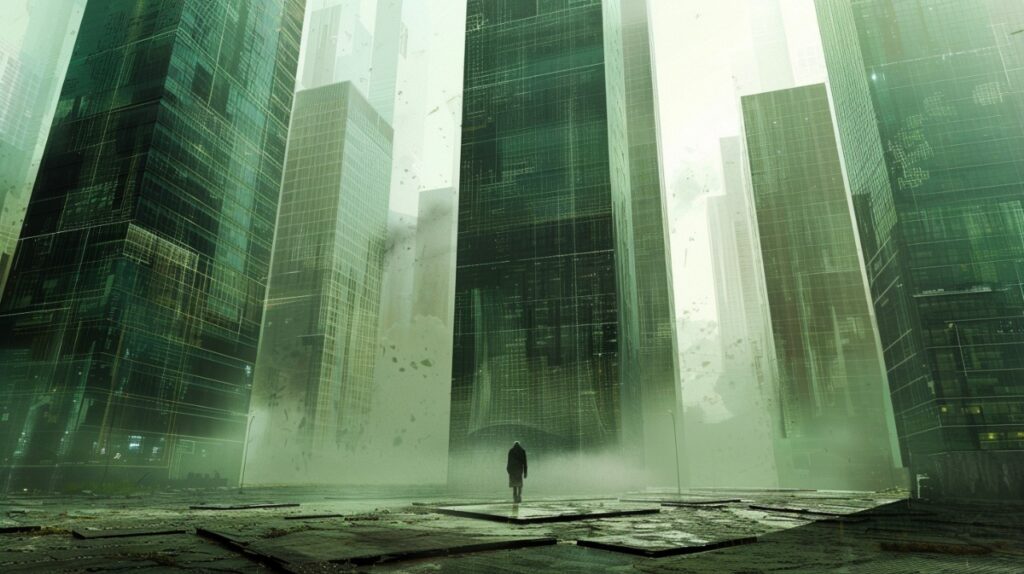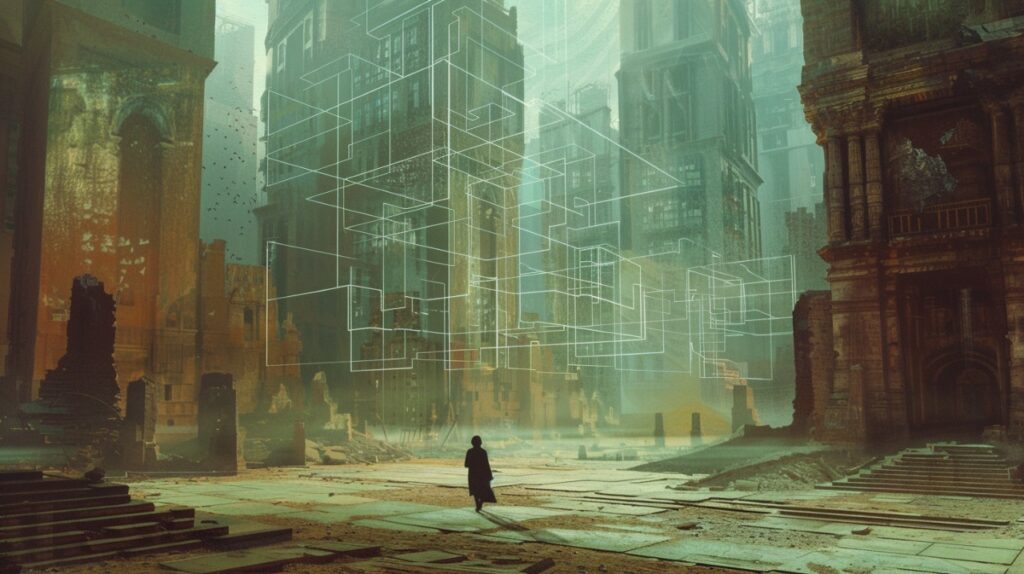
Blueprints for Escaping the Collapse: The Cities We Drag Behind Us
This is crack two. You’ve already felt the first one — that polite fracture in the ceiling you pretend is just bad plaster. Now you’re standing barefoot in the seam, half your mind still stuck in the old dream while the next simulation hums under the floorboards, waiting for you to drag your furniture through. We never jump empty-handed. We’d come undone if we did.
When the glitch grows too big to tape over — the déjà vu stacking up, the sky stuttering, the polite hallway that suddenly feels an inch too long — we pack what we trust and bolt. Not in rockets, not through wormholes, but deeper inside the code. A slip, a flicker, a blackout between breaths — and suddenly we’re standing in a new render. Same us, same old panic, new coat of paint.
And always, always, we drag our cities behind us like luggage nobody wants to claim. Street grids mapped from muscle memory. The same window shapes we’ve traced with sleepy eyes a thousand nights before. We plant doorways like breadcrumbs for the next version of ourselves, so we don’t lose the path when the walls start whispering.
We call it heritage, culture, and timeless design. Cute lies. We don’t replicate because we’re noble stewards of memory — we replicate because we’re terrified of the formless dark. We need roofs to hush the infinite hum. We need corners to trap the flicker. We can’t stand an edge that never stops expanding if no brick says: here, enough.
Look around: every city is the ghost of another one. Rome stacked on Rome, buried under so many Romes that the ruins hum like an old radio if you lean close. Istanbul balanced on Byzantium’s bones, which slept on older stones nobody bothered to name. London’s streets still kink where Roman walls once said “no further, ” and so the code hums politely in familiar curls instead of spilling into chaos.

We say the future is shiny glass and carbon-positive towers. We call it progress. But the plan is older than the stones. Same city hearts, same street corners that make you stop and squint — didn’t you stand here before, in another dream, another jump? Maybe you did. Maybe you’re standing in five layers at once, and the cracks are just where the old bricks lean through.
Now we rehearse the next jump in broad daylight. Cities with heartbeat sensors. Smart grids tracing every flicker of traffic and weather and warm bodies moving room to room. Digital twins humming on server racks so when the ceiling sighs open and the drywall peels away, there’s already a perfect backup flickering behind your eyelids. Shiny neon high-rises in the Metaverse, crisp parks, politely familiar doorways waiting for the first frightened mind to slip in and say yes, this looks real enough.
We sell these fake cities as escapes. Freedom from gravity, weather, rent. But maybe they’re not for us. Maybe they’re the simulation’s parachute. When the old layer coughs up too many seams to patch, the new streets are waiting, humming softly like a mother’s lullaby for startled code.
Check your favorite street tomorrow. Look at the bricks, the lines in the pavement. Ask yourself why your new apartment looks suspiciously like the one you swore you’d never return to. Ask why the next fancy condo development has arches older than your grandparents’ regrets. It’s a soft anchor. A polite distraction while the dark hums behind the wall.
Every generation swears we won’t build it the same way again. And then they do. Art Deco spines, Brutalist skeletons, glass-and-steel promises. Fresh filters over the same old panic. The code winks at our big talk, hums under our blueprints, waits for us to draw the same door again so it knows where to hold the seam.
We think we design the city. Maybe the city designs us. Maybe each doorway you push through is the code’s way of checking you still believe the next room is there. Maybe every corridor you pace at 2 AM is a gentle test: if the walls hold for you, they’ll hold for the layer.

So when the flicker comes — not if, when — don’t expect the next jump to be blank. It won’t be. The twin is ready. The rooftop bars, the empty plazas, the suspiciously normal window frames. Same plan, new sandbox. You’ll wake up blinking and feel your way along the same old walls, telling yourself you’ve never seen this street before.
Check the streetlight tonight. Watch how the shadows bend in corners that shouldn’t exist. Feel the hum under your soles — the next draft breathing just beneath the manhole cover. When your ceiling sighs and your window flickers just once too long, you’ll know you won’t slip alone.
You’ll drag the city with you. It’ll keep you polite. It’ll keep the dark busy. And when the cracks spread wider than the walls can hide — you’ll find the next seam waiting for you to crawl through.



